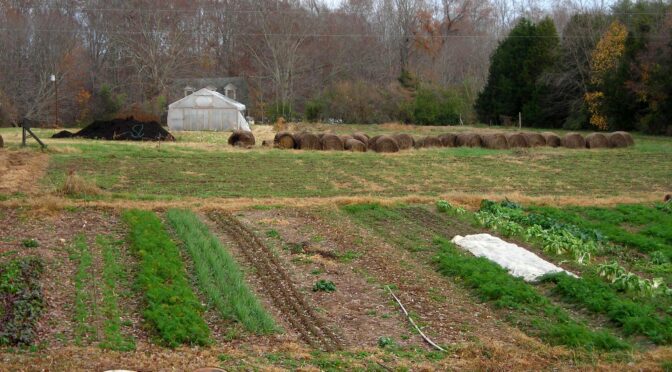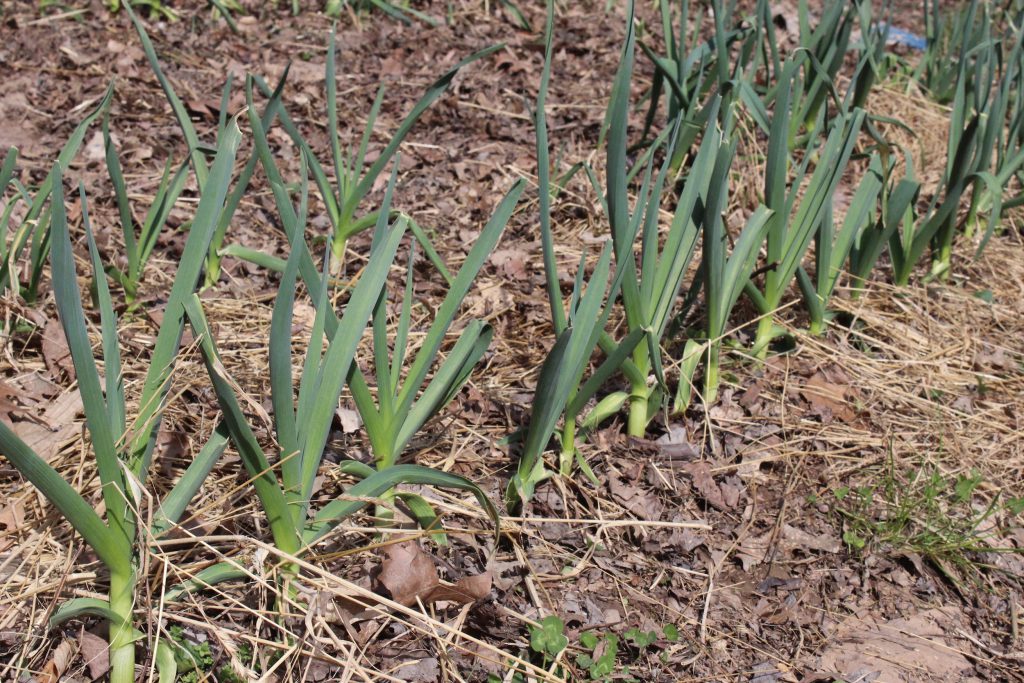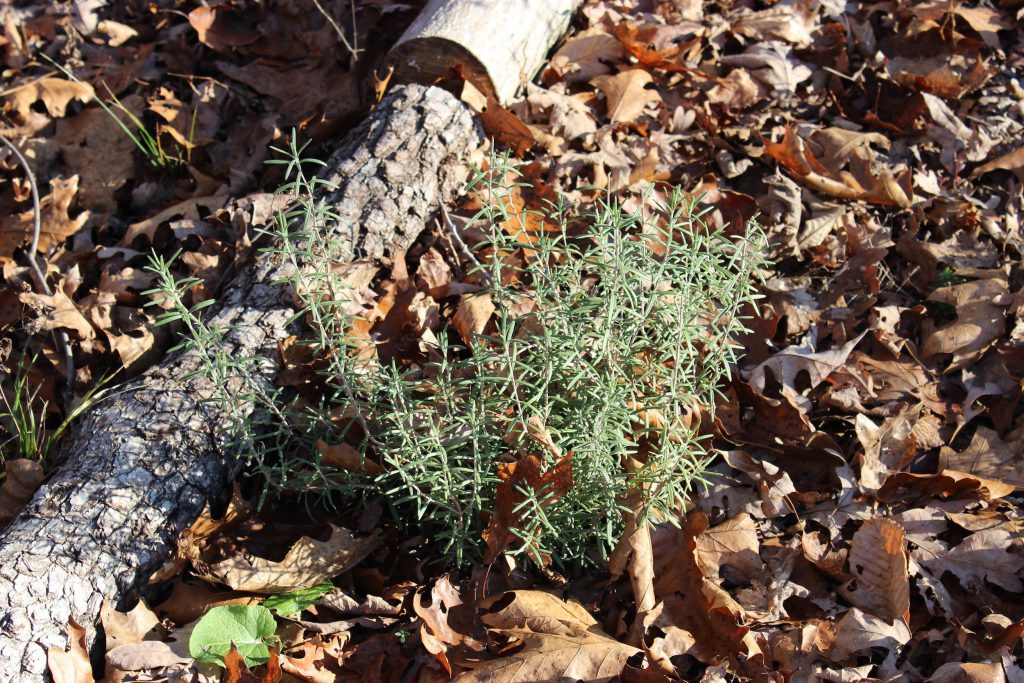It’s officially autumn. We’re finishing up with the major summer harvests, but September and October are still important months in the garden. This fall, a few chores can help you have winter harvests, build healthy soil, and have a beautiful, productive garden next season. Here are a few of the tasks we think it’s important to consider this time of year.
Buy and plant perennial onions, garlic, shallots, and bulbs.
Spring isn’t the only planting season. If you haven’t already, it’s time to select and order perennial onions, garlic, shallots, and certain fall-planted flower bulbs like daffodils and tulips. The sooner you order, the larger the selection you’ll have to choose from.
Exact planting dates may vary depending on your hardiness zone, but here in Virginia, it’s best to plant them between September 15th and November 15th.
Think about winter composting.
It takes a bit of work, but you can keep composting all winter. We recommend building a large pile and covering it to give your compost more protection from the elements. We have a whole article which you can find here for those interested in making compost all winter long.
Add more mulch.
September and October are good times to apply a layer of mulch before winter. We like to mulch around perennials like asparagus, fruit trees, rhubarb, strawberries, and in between rows of fall crops. Mulch will help keep the soil around these plants warmer for a little longer and helps prevent heaving.
Sow more quick-growing fall veggies.
In zone 7a, where we’re located and farther south, you’ve still got time to sneak in a few more crops. You can still sow mustards, spinach, radishes, and turnips.
Create season extension.
You don’t need a fancy greenhouse to extend your garden’s season. There are many affordable, easy ways to give fall and winter crops a little extra protection. From low tunnels to hotbeds, check out all of our ideas on our post, Easy Season Extension for Fall.
Sow fall cover crops.
If you only complete one fall gardening task, it should be to sow fall cover crops. Fall cover crops have a myriad of benefits. They protect soil from erosion, add organic matter, encourage beneficial insects, and more. Some of our favorites include crimson clover, winter rye, hairy vetch, Austrian winter peas, and white dutch clover. Learn more about choosing a winter crop for your garden and how to plant them here.
Collect leaves.
Autumn leaves are gold for gardeners! They’re a great carbon-rich ingredient to add to your homemade compost, and they make excellent mulch by themselves. You can also shred them to create leaf mold for DIY potting mixes.
All you need is a rake and somewhere to pile them where they won’t blow away. Multi-bin compost set-ups are great for this. You may also be able to collect them from friends and neighbors too. Just make sure the yards you’re getting them from haven’t been treated with herbicides that could contaminate your garden.
Be diligent about draining your hose and sprinkler.
Depending on where you’re located, the first fall frosts are getting closer. It’s time to make sure you drain any sprinklers and nozzles and disconnect hoses after each use. Taking care of your equipment this fall means you won’t have to buy new next spring.

Save seeds.
In much of the Southeast and Mid-Atlantic, September and even October are still bringing in good harvests. This can also be an excellent time to save seed from some of your favorite varieties. Check out our Seed Saving for Beginners article to learn how to save seed from tomatoes, cucumbers, squash, pumpkins, peppers, peas, and beans. Here are some of our other favorite seed saving posts:
- Easy Seed Saving with Promiscuous Pollination
- Seed Saving from Biennial Crops
- Saving Lettuce Seed
- Seeds: Tips for Storing, Testing, & Saving
- 7 Steps to Saving Cucumber Seed
- Garden Planning for Seed Saving
- Seed Saving: Selecting Plant Characteristics
- Fall Reads: Five Books on Seed Saving
Get a soil test.
Testing your soil is an often overlooked aspect of gardening. Fall is a great time to get this done so you can amend your garden before next season. Especially if you consistently struggle with certain crops, a soil test can make a huge difference in your gardening success. Soil tests will tell you the availability of macro and micronutrients in your garden, as well as the soil pH. They’re readily available through most county extension agencies.
Check out Understanding Soil Tests to learn more.
Leave some standing dead plants.
It can be tempting to give your garden a clean sweep in the fall but don’t do it! Leave some standing dead material like echinacea, sunflower, and other flower stalks. These are vital habitats for many beneficial insects, and they often provide winter food sources and perches for songbirds.
The exception to this is removing pest-ridden or diseased material such as tomato plants with fungal diseases or dead asparagus stalks that had asparagus beetles. We recommend burning material like this as most home composts don’t get hot enough to kill insects and diseases.
Continue watering.
If your area is getting plenty of rain, this won’t be an issue. However, if you’re still experiencing some warm, dry spells, keeping up with watering is vital. Water any fall crops that are still growing and perennials, especially those you just planted this year.
Store crops properly.
If you’re still bringing in crops, it’s essential to harvest, cure, and store them properly. Here are a few of our guides to help you put up the harvest:
- Putting Up produce the Old Ways: Fermenting, Drying, and Cellaring
- How to Store Crops Without a Root Cellar
- Harvesting & Curing Winter Squash & Pumpkins
- Growing, Using, & Storing Staple Crops Part 1
- Growing, Using, & Storing Staple Crops Part 2
- How to Properly Harvest & Preserve Herbs
Sow flowers.
It may come as a surprise to some but fall is a great time to start your spring flower garden. Many cool-weather loving flowers are great for fall sowing, including violas, sweet peas, echinacea, and coreopsis. Check out our Spring Flowers: Fall Sowing post for more ideas and a few planting tips.
There are so many fall activities to enjoy, but don’t forget to take some time for your garden. Cool fall weather is the perfect time to complete these essential garden tasks.




